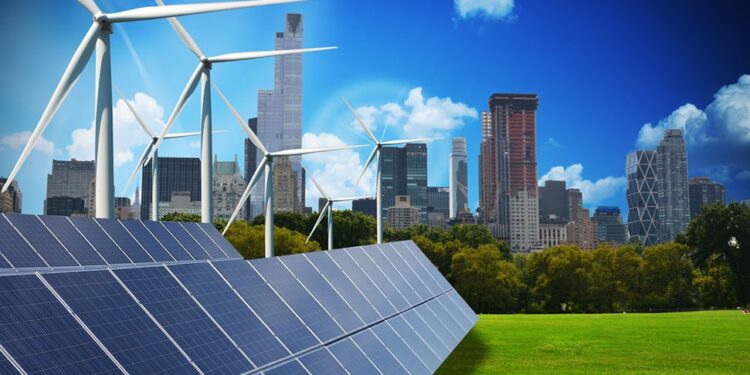What Is Renewable Energy?

Renewable energy is a topic that is has increased importance as time goes on. With the progression of climate change, it is becoming vital to find sustainable energy sources that will not damage the environment. Renewable energy is power that comes from a source that is not exhausted or depleted when used. This means that we can use it repeatedly without damaging the environment.
Renewable energy sources include solar, wind, water, and geothermal. With the help of renewable energy, we can take steps to protect our environment and ensure a bright future for generations to come.
Solar Panels
Solar panels convert sunlight into electricity. They are panels made up of photovoltaic cells, semiconductors that absorb sunlight and create an electric voltage. Solar panels are suitable for various applications, including residential and commercial rooftops, farms, and power plants.
Solar panels have many benefits over traditional energy sources. Solar panels are also very efficient, converting up to 20% of the sunlight they receive into electricity. The main disadvantage of solar panels is their initial cost, although in the last decade, the price has dropped significantly to an affordable level for most people.
Solar panels require very little maintenance, as the cells only need to be cleaned occasionally and the panel angle checked to maximize sunlight exposure.
Solar panels play a key role in reducing our dependence on fossil fuels and helping combat climate change.
Wind Turbines
Wind turbines are one of the most used renewable energy sources. They work by converting the kinetic energy of the wind into electrical energy. Wind turbines can generate electricity for a single home or extensive commercial facilities.
Wind patterns and speeds vary significantly in different regions of the UK and are affected by bodies of water, foliage, and terrain. Humans use wind for many purposes, including sailing, kite flying, and generating electricity.
A wind turbine creates electricity from the wind using the aerodynamic force from rotor blades, which work like helicopter rotor blades. As wind rushes across the blades, the air pressure on one side of the blade drops. The difference in pressure across the blade’s two sides creates lift and drag. The force of the lift is more powerful than the drag, which make the rotor spin.
The rotor connects to a generator. The translation of aerodynamic force to the generator creates electricity.
Hydropower
Hydropower is another renewable energy source used to generate electricity. Hydropower uses the force of moving water to turn turbines, which power generators to produce electricity. Water is constantly in motion due to the forces of gravity and evaporation. This means hydropower is an ongoing and consistent energy source.
We can build hydropower plants in a variety of ways. The most common type of hydropower plant is an impoundment facility. This type of facility uses a dam to store water in a reservoir. When the water is released from the reservoir, it flows through a turbine, which generates electricity.
Another type of hydropower plant is a run-of-the-river facility. This type of facility does not use a dam to store water. Instead, water is diverted from a river through a pipeline and then flows through a turbine to generate electricity.
The final type of hydropower plant is a pumped storage facility. This type of structure is used to store energy. It uses excess electricity to pump water from a lower reservoir to an upper reservoir. When electricity is needed, the water is released from the upper pool and flows through a turbine to generate electricity. Hydropower is a reliable source of electricity, and we can use it to supplement other power sources.
Geothermal
The Earth’s internal heat energy is the source of geothermal energy. The heat is produced by decomposing radioactive elements, the gravitational compression of the Earth’s molten core, and the heat from the Earth’s formation. The heat is transferred to the surface of the Earth by conduction, convection, and radiation. We can use geothermal energy for various purposes, including generating electricity, heating buildings, and industrial processes.
Heat is continually transferred from the Earth’s interior to the surface through convection in the mantle, the solid inner core and the liquid outer core. There are three types of geothermal resources: hydrothermal convective, hydrothermal reservoir, and hot dry rock.
Hydrothermal convective systems are the most common type of geothermal resource. They are created when water seeps into cracks in the Earth’s surface and is heated by the Earth’s heat. The water then rises to the surface and produces geysers and hot springs.
Hydrothermal reservoirs form when water is trapped in porous rock and is heated by the Earth’s heat. We can use the water in these reservoirs to generate electricity.
Geothermal energy has several advantages over other renewable and non-renewable energy sources. It is not affected by weather or climate. Geothermal energy is obtainable 24 hours a day, seven days a week.
Geothermal power plants have a low carbon footprint and do not produce air pollution or greenhouse gases, but there are some disadvantages: Geothermal power plants need a large amount of land.
They can be expensive to build.
There is also the potential for environmental impacts, such as earthquakes, ground subsidence, and water pollution.
Despite the disadvantages, geothermal energy is a very promising renewable energy source.
Each type of renewable energy has its benefits and drawbacks, but overall, renewable energy is a cleaner and much more sustainable option than fossil fuels for future energy production to protect the environment.




